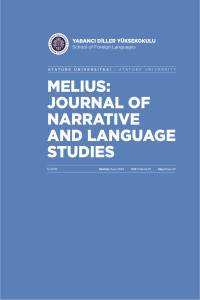Heather Raffo’nun 9 Parts of Desire (Tutkunun 9 Parçası) Adlı Tiyatro Eserinin Analizi
Cinsiyet kavramı, tarihteki çalkantılı dönem ile birlikte kadınlar için, özellikle Iraktaki kadınlar, karmaşık bir durumdur ve bu nedenle buradaki pek çok kadın hem cinsiyet açısından hem de ırksal anlamda sıkıntılar yaşamaktadır. Yalnızca cinsel saldırı değil, bunun yanı sıra ataerkil toplum fiziksel ve psikolojik olarak baskı uygulamaktadır. Heather Raffo’nun 9 Parts of Desire adlı eseri, pek çok farklı kadının yaşamlarındaki farklı kimlikleri ve tecrübeleri nasıl yansıttığını gösteren önemli bir örnektir. Fakat her bir karakter tek bir şey için savaşmaktadır: aşk. Kıyafet kuralları ya da dinsel kısıtlamalar ile ataerki düzenler oyunda Iraklı kadınlar için sınırlı bir alan oluşturur ve oyun boyunca her bir karakter bağımsızlarını arar. Bazıları kendi memleketlerinden kaçarlarken, bazıları ise özgürlük için kalıp savaşırlar, ama oyundaki her bir karakter cesur kalpleriyle zorluklar karşısında mücadele etmektedir. Bu çalışma, kimlik, ırk ve cinsiyet açısından bu kadınları incelemektedir. Bu yaklaşımlar arasında cinsiyet teorisi, 9 kadının tutku arayışlarıyla oyunun özünü yansıtacaktır. Tiyatro oyunu aynı zamanda kadınları lirik bir anlatımla ifade eder ve bu nedenle poetik monolog şeklinde sunulmuştur. Homi Bhaabha, Stuart Hall ve Julia Kristteva gibi farklı teorisyenler sayesinde, çalışma Orta Doğu Amerikan Tiyatrosunda otantik bir bakış açısı yaratmayı hedeflemektedir.
The Analysis of Heather Raffo’s 9 Parts of Desire
Gender is a complex issue especially for women in Iraq beside the historical tumultuous period, and so many women suffer from both gendered and racial hardships. Not only sexual harassment but also patriarchal society oppresses their physical and psychological state of minds. Heather Raffo’s 9 Parts of Desire is a great symbolization for indicating how diverse women portray different identities and experiences in their lives. However, each of them fights for one thing: love. Patriarchal regulations with its clothing rules or religious restrictions create limited space for Iraqi women in the play, and they search for liberation throughout the play. Some escape from their home countries, or some stay and fight for liberation. However, each character in the play struggles against difficulties with her brave heart. This study will examine these women in terms of identity, racial and gendered theories. Among these approaches, the gender theory will shed light on an essence of the play due to deal with nine women’s searching of desire. The play also reflects these women with their lyrical statements and so it is an important point that the theatrical play is narrated in a poetic monologue. Thanks to various theorists such as Homi Bhabha, Stuart Hall and Julia Kristeva, the study creates authentic perspectives in the field of Middle Eastern American Drama.
___
- Beauvoir, S. de. (2010). The Second Sex. Trans. Borde, Constance and Sheila Malovany Chevallier. Vintage Classics. NY.
- Bhabha, H. K. (1994). The Location of Culture. Routledge. NY.
- Boehmer, E. (2005). Colonial and Postcolonial Literature: Migrant Metaphors. (2nd ed.). Oxford University Press.
- Delgado, R. (2009). Affirmative Action as a Majoritarian Device: Do You Want to be a Role Model? Foundations of Critical Race Theory in Education. New York: Routledge.
- Hagerty, B. M., Williams, R. A., & Oe, H. (2002). Childhood antecedents of adult sense of belonging. Journal of Clinical Psychology, 58(7), 793–801. https://doi.org/10.1002/jclp.2007
- Hall, S. and Paul du G. (1996). Questions of Cultural Identity. SAGE Publications. “heatherraffo.com” Heather Raffo Bio. 2011. Web.
- Kristeva, J. (1982). Powers of Horror an Essay on Abjection. Trans. Roudiez, Leon S. New York: Columbia UP.
Lahr, J. (2004). The Critics: The Theater: The Fury and the Jury: Women, and Men, Make Themselves Heard—the New Yorker.
- Mahadi, Tengku S. and Maysoon Taher M. (2012). Shahrzad Tells her Stories in Raffo’s Nine Parts of Desire. International Journal of Social Sciences and Education. Universiti Sains Malaysia, Volume: 2 Issue: 1.
- Teachout, T. (2005). Invisible Women. The Wall Street Journal. Retrieved from https://www.wsj.com/articles/SB110565623580225747
- Raffo, H. (2006). 9 Parts of Desire. Northwestern University Press. Evanston, Illinois.
- Renner, P. (2005). Iraq Through the Eyes of Its Women. American Theater, 22.4, April.
